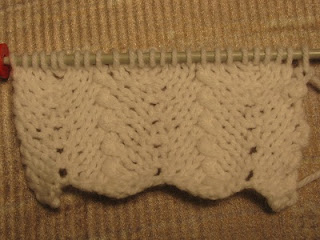Knitted Ripple Stitch Afghans are much simpler to make than might appear from the actual knitting pattern.
This article will explain the basic concepts behind the Ripple Stitch.
Key features of Ripple Stitch
- The knitted fabric looks like a big zigzag, with mountains and valleys. The bottom and top edges look like the letter W. This is formed by matching pairs of double-increases (where 3 stitches come out of 1) and double-decreases (where 3 stitches become 1).
- The pattern is typically just a two-row repeat, with a complex row alternating with a plain row.
- The number of stitches on the needle is the same from one row to the next.
- Often, projects made using the Ripple Stitch are made in multiple colors. The best part is that you only use one color of yarn per row.
The main repeat in Ripple Stitch usually consists of a double-increase, then knitting a number of stitches, then a double-decrease, then knitting another set of stitches. Typically, the number of stitches between the double-increases and double-decreases is the same.
A project made with Ripple Stitch is usually symmetrical, so outside the main repeat is one more double-decrease or double-increase. But this would change the number of stitches on the needle. So a double-decrease is balanced by a single-increase at each side. And a double-increase is balanced by a single-decrease at each side.
Example of a Ripple Stitch pattern row
Row 2: K2tog. K3. *(K1. P1. K1.) all in next st. K3. Sl1. K2tog. Psso. K3. Rep from * to last 8 sts. (K1. P1. K1.) all in next st. K3. Sl1. K1. Psso.
Let’s break this down a bit.
- The beginning: K2tog. K3.
- The repeat: *(K1. P1. K1.) all in next st. K3. Sl1. K2tog. Psso. K3.
- The ending: (K1. P1. K1.) all in next st. K3. Sl1. K1. Psso.
Look at the repeat first.
The phrase “(K1. P1. K1.) all in next st.” is a double-increase. The phrase “Sl1. K2tog. Psso.” is a double-decrease.
The K3 in the middle and at the end of the repeat is the distance between the double-increases and double-decreases.
So, just as described above, the repeat consists of: double-increase, K3, double-decrease, and K3.
Now, add the little bits that make the pattern symmetrical. Look at both the beginning and ending parts of the row:
- The beginning: K2tog. K3.
- The ending: (K1. P1. K1.) all in next st. K3. Sl1. K1. Psso.
The ending starts with the double-increase. There’s the symmetry. So all that’s left are the side sections.
The beginning starts with a single-decrease, the K2tog. And the ending finishes with another single-decrease, the SKP, or Sl1-K1-PSSO sequence. These two types of decrease have a different slant to them, so they provide symmetry.
Between the increases and decreases is that K3 bit – just like in the repeat.
Conclusion
That’s how easy it is to read – and understand – the knitting pattern for a Ripple Stitch Afghan.

No comments:
Post a Comment